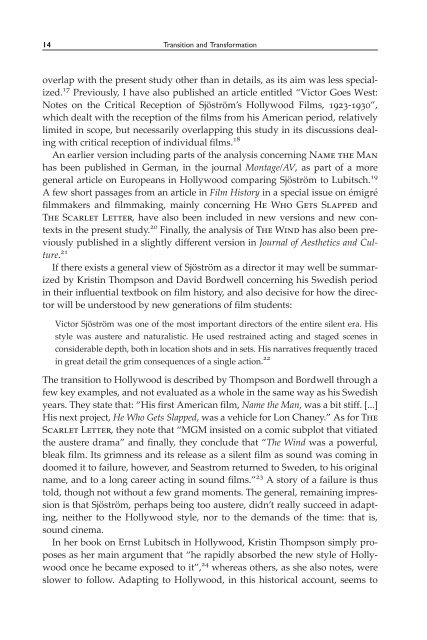FILM FILM - University of Macau Library
FILM FILM - University of Macau Library
FILM FILM - University of Macau Library
You also want an ePaper? Increase the reach of your titles
YUMPU automatically turns print PDFs into web optimized ePapers that Google loves.
14 Transition and Transformation<br />
overlap with the present study other than in details, as its aim was less specialized.<br />
17 Previously, I have also published an article entitled “Victor Goes West:<br />
Notes on the Critical Reception <strong>of</strong> Sjöström’s Hollywood Films, 1923-1930”,<br />
which dealt with the reception <strong>of</strong> the films from his American period, relatively<br />
limited in scope, but necessarily overlapping this study in its discussions dealing<br />
with critical reception <strong>of</strong> individual films. 18<br />
An earlier version including parts <strong>of</strong> the analysis concerning Name the Man<br />
has been published in German, in the journal Montage/AV, as part <strong>of</strong> a more<br />
general article on Europeans in Hollywood comparing Sjöström to Lubitsch. 19<br />
A few short passages from an article in Film History in a special issue on émigré<br />
filmmakers and filmmaking, mainly concerning He Who Gets Slapped and<br />
The Scarlet Letter, have also been included in new versions and new contexts<br />
in the present study. 20 Finally, the analysis <strong>of</strong> The Wind has also been previously<br />
published in a slightly different version in Journal <strong>of</strong> Aesthetics and Culture.<br />
21<br />
If there exists a general view <strong>of</strong> Sjöström as a director it may well be summarized<br />
by Kristin Thompson and David Bordwell concerning his Swedish period<br />
in their influential textbook on film history, and also decisive for how the director<br />
will be understood by new generations <strong>of</strong> film students:<br />
Victor Sjöström was one <strong>of</strong> the most important directors <strong>of</strong> the entire silent era. His<br />
style was austere and naturalistic. He used restrained acting and staged scenes in<br />
considerable depth, both in location shots and in sets. His narratives frequently traced<br />
in great detail the grim consequences <strong>of</strong> a single action. 22<br />
The transition to Hollywood is described by Thompson and Bordwell through a<br />
few key examples, and not evaluated as a whole in the same way as his Swedish<br />
years. They state that: “His first American film, Name the Man, was a bit stiff. [...]<br />
His next project, He Who Gets Slapped, was a vehicle for Lon Chaney.” As for The<br />
Scarlet Letter, they note that “MGM insisted on a comic subplot that vitiated<br />
the austere drama” and finally, they conclude that “The Wind was a powerful,<br />
bleak film. Its grimness and its release as a silent film as sound was coming in<br />
doomed it to failure, however, and Seastrom returned to Sweden, to his original<br />
name, and to a long career acting in sound films.” 23 A story <strong>of</strong> a failure is thus<br />
told, though not without a few grand moments. The general, remaining impression<br />
is that Sjöström, perhaps being too austere, didn’t really succeed in adapting,<br />
neither to the Hollywood style, nor to the demands <strong>of</strong> the time: that is,<br />
sound cinema.<br />
In her book on Ernst Lubitsch in Hollywood, Kristin Thompson simply proposes<br />
as her main argument that “he rapidly absorbed the new style <strong>of</strong> Hollywood<br />
once he became exposed to it”, 24 whereas others, as she also notes, were<br />
slower to follow. Adapting to Hollywood, in this historical account, seems to

















